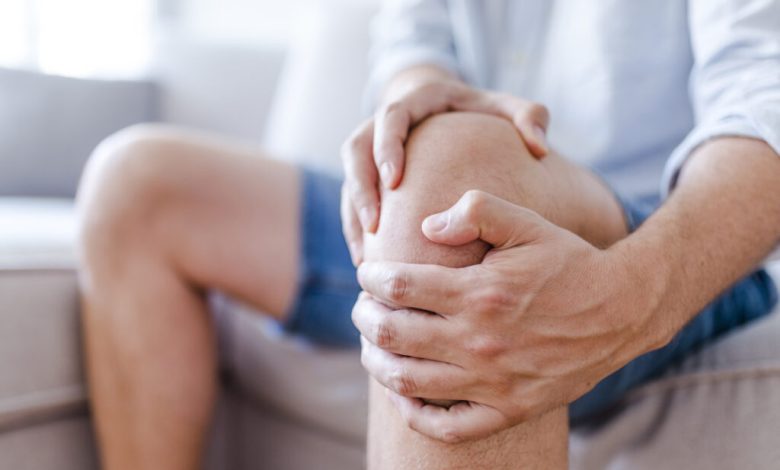3 Science-Backed Ways to Avoid a Knee Replacement (Your Orthopedic Surgeon Won’t Tell You!)

Knee pain can feel like a thief—slowly stealing your mobility, independence, and joy. For millions of people, especially those over 50, chronic knee pain is often blamed on “wear and tear” or osteoarthritis. The standard medical advice? Eventually, a knee replacement.
But here’s the truth your orthopedic surgeon might not tell you: you can often delay—or even avoid—a knee replacement altogether.
Modern research has revealed remarkable, science-backed strategies that can protect your knees, rebuild cartilage health, reduce inflammation, and restore function—without going under the knife.
Uncover three proven methods to help you keep your natural knees strong, stable, and pain-free.
Why Avoiding a Knee Replacement Matters
Before diving into the science-backed methods, it’s important to understand why avoiding or delaying a knee replacement can be so beneficial.
Knee replacement surgery is one of the most common orthopedic procedures worldwide, but it’s not without risks. Studies show that up to 20% of patients experience persistent pain even after surgery, and recovery can take months. Moreover, artificial knees don’t last forever—typically 15 to 20 years—which means younger patients may face a second, more complicated revision surgery later in life.
Other potential complications include:
- Post-surgical infection
- Blood clots
- Nerve damage
- Reduced range of motion
- Chronic swelling or stiffness
And let’s not forget the emotional and financial toll—weeks of downtime, high costs, and the stress of rehabilitation.
The good news? Science shows that you can often rehabilitate, rebuild, and rejuvenate your knees naturally—if you start now.
1. Strengthen the Muscles That Support the Knee
Why Muscle Strength Matters
Your knee joint is a hinge between two powerful levers—your thigh bone (femur) and shin bone (tibia). It’s supported by muscles, tendons, and ligaments that absorb shock and stabilize movement. When these muscles—especially the quadriceps, hamstrings, and glutes—weaken, the knee takes more stress, accelerating cartilage wear and pain.
Research published in the Arthritis Care & Research Journal found that quadriceps weakness is one of the strongest predictors of knee osteoarthritis progression. In contrast, people who maintain or build muscle strength experience less pain and slower cartilage degeneration.
The Science-Backed Solution: Targeted Strength Training
Several studies highlight that progressive resistance exercise—specifically tailored to the knees—can dramatically improve joint function and reduce pain.
Related Article: Joint Support: Natural Joint Supplement for Arthritis Joint Relief Review
Key Exercises to Rebuild Knee Strength
- Wall Sits:
Build quadriceps endurance without putting pressure on the joint.
Hold for 30 seconds to 1 minute, repeat 3 times. - Mini Squats:
Perform shallow squats, keeping knees behind toes to protect the joint.
Do 10–15 reps, 3 sets. - Glute Bridges:
Strengthen glutes and hamstrings, which help align and stabilize the knee.
Hold for 10 seconds, repeat 15 times. - Step-Ups:
Mimic natural movements that improve knee tracking and coordination.
Use a step or low bench, 10 reps each leg. - Resistance Band Leg Extensions:
Activate quadriceps with controlled tension, reducing joint load.
Low-Impact Options That Protect the Knee
Not all exercise is good for arthritic knees. High-impact activities like running can worsen pain, while low-impact exercises such as:
- Cycling
- Swimming
- Elliptical training
- Pilates or yoga
These support joint mobility while building strength and flexibility.
Clinical Evidence
A 2021 meta-analysis in The Journal of Orthopaedic & Sports Physical Therapy confirmed that strength training combined with aerobic exercise significantly improves knee pain, function, and quality of life in osteoarthritis patients—often matching or exceeding the results of medications or injections.
Bottom line: Building muscle around the knee is one of the most effective non-surgical ways to protect cartilage and reduce pain. Strong muscles mean less stress on the joint—delaying or preventing the need for replacement.
2. Reduce Inflammation with Science-Backed Nutritional Interventions
The Hidden Role of Inflammation
Chronic knee pain isn’t just mechanical—it’s biochemical. Persistent inflammation erodes cartilage, irritates joint linings, and amplifies pain signals. If you want to preserve your knees, you must reduce inflammation at the cellular level.
Your orthopedic surgeon might not discuss nutrition, but it plays a major role in joint longevity. What you eat can literally decide whether your cartilage heals or breaks down.
The Anti-Inflammatory Diet for Knee Health
Studies show that diets high in omega-3 fatty acids, antioxidants, and polyphenols can significantly reduce joint inflammation and pain.
Foods That Fight Inflammation
- Fatty fish (salmon, mackerel, sardines): Rich in omega-3s that inhibit inflammatory cytokines.
- Olive oil: Contains oleocanthal, which acts like a natural ibuprofen.
- Turmeric (Curcumin): Clinically proven to reduce knee osteoarthritis pain.
- Ginger: Shown to lower prostaglandin activity (pain mediators).
- Leafy greens and berries: Packed with antioxidants that protect cartilage.
- Green tea: Contains EGCG, a compound known to suppress joint inflammation.
Foods to Avoid
- Processed sugars and refined carbs
- Red or processed meats
- Trans fats and vegetable oils (corn, soy, sunflower)
- Excess alcohol
Supplements with Proven Joint Benefits
Clinical studies have identified several supplements that support joint repair and reduce inflammation naturally.
- Curcumin (Turmeric Extract):
A double-blind trial published in Phytotherapy Research found that 1,000 mg/day of curcumin was as effective as ibuprofen in reducing knee pain—without side effects. - Collagen Peptides:
Collagen is the main protein in cartilage. Supplementation helps rebuild joint structure. A 2022 study in Nutrients found improved knee mobility and reduced stiffness in participants after 12 weeks of collagen use. - Boswellia Serrata (Indian Frankincense):
Known for powerful anti-inflammatory effects. Studies show reduced pain and improved function in osteoarthritis within 8 weeks. - Glucosamine and Chondroitin:
While results vary, some high-quality studies suggest they can slow cartilage loss and enhance joint lubrication. - Omega-3 Fatty Acids (Fish Oil):
Lower systemic inflammation markers and improve overall joint comfort.
Hydration and Cartilage Health
Cartilage is about 80% water. When you’re dehydrated, joint tissues lose their elasticity, increasing friction and pain.
Aim for at least 8–10 glasses of water per day, and include electrolytes if you sweat heavily or live in hot climates.
Bottom line: The food and supplements you choose can either fuel inflammation—or fight it. A joint-friendly, anti-inflammatory diet is one of the simplest and most effective ways to preserve your knees naturally.
3. Restore Joint Function with Regenerative and Physical Therapies
The Problem with “Wait and Replace”
Many orthopedic surgeons follow a traditional protocol: pain → painkillers → steroid injections → knee replacement.
This approach doesn’t address the root cause of knee deterioration—it only manages symptoms.
Thankfully, modern regenerative medicine and advanced physical therapies offer alternatives that can help restore natural healing within the joint.
A. Regenerative Medicine: Science-Based Healing from Within
1. Platelet-Rich Plasma (PRP) Therapy
PRP involves concentrating your own platelets (from blood) and injecting them into the knee. Platelets release growth factors that stimulate tissue repair, reduce inflammation, and encourage cartilage regeneration.
Evidence:
A meta-analysis published in The American Journal of Sports Medicine (2021) found that PRP injections significantly reduced knee pain and improved function for up to 12 months—superior to hyaluronic acid or corticosteroid injections.
2. Stem Cell Therapy
Derived from your bone marrow or adipose tissue, stem cells can differentiate into cartilage-producing cells, helping repair damaged joint tissue.
Evidence:
A 2022 study in Stem Cells Translational Medicine showed that stem cell therapy reduced pain and improved mobility in osteoarthritis patients—without major side effects. While it’s still under study, results are promising for those seeking non-surgical cartilage regeneration.
B. Physical and Manual Therapies: Restoring Natural Movement
1. Physical Therapy
Targeted physiotherapy helps:
- Improve range of motion
- Retrain walking patterns
- Strengthen supporting muscles
- Reduce stiffness and inflammation
A 2020 randomized controlled trial found that physical therapy was as effective as knee replacement in improving pain and function over one year—for many patients with moderate osteoarthritis.
2. Shockwave Therapy
This non-invasive treatment uses sound waves to stimulate healing and improve circulation around the joint. Research shows it can reduce chronic pain and stiffness when combined with exercise therapy.
3. Hydrotherapy (Water Therapy)
Water reduces joint stress while allowing for full-range movement. Aquatic exercise has been shown to improve muscle strength, flexibility, and overall joint comfort.
C. Mind-Body Approaches for Long-Term Relief
Chronic pain isn’t just physical—it’s also neurological.
Techniques like mindfulness meditation, deep breathing, and yoga can help modulate pain perception and reduce stress-related inflammation.
A 2018 Harvard study found that mind-body interventions lowered inflammatory biomarkers (like CRP) and improved mobility in osteoarthritis patients.
Bottom line: Combining regenerative therapies, physical rehab, and mind-body balance can restore function and delay the need for surgery—by supporting the body’s natural healing systems.
When Surgery Might Still Be Necessary
It’s important to note that not everyone can avoid knee replacement indefinitely. Severe bone-on-bone arthritis, advanced deformity, or loss of function may make surgery the best option.
However, applying these science-backed strategies early and consistently can help:
- Delay the need for surgery by years
- Improve surgical outcomes if it becomes necessary
- Reduce overall pain and disability
A Step-by-Step Plan to Protect Your Knees Naturally
Here’s how to put everything together:
Step 1: Start a Targeted Exercise Routine
- Focus on low-impact strength training 3–4 times per week.
- Incorporate stretching and mobility work daily.
- Gradually increase intensity—never push through sharp pain.
Step 2: Eat for Anti-Inflammatory Power
- Add fatty fish, olive oil, turmeric, and green tea.
- Avoid processed foods and sugary snacks.
- Consider supplements like collagen, curcumin, and omega-3s (after consulting your healthcare provider).
Step 3: Explore Regenerative and Physical Therapies
- Consult a sports medicine or regenerative specialist for PRP or stem cell options.
- Begin physiotherapy focused on strengthening and realignment.
- Consider hydrotherapy or gentle yoga for flexibility.
Step 4: Manage Stress and Pain Naturally
- Practice mindfulness, deep breathing, or guided relaxation.
- Get 7–8 hours of sleep—your joints repair during rest.
- Maintain a healthy weight to reduce joint load.
The Takeaway: You Have More Control Than You Think
Your knees are not doomed to fail just because of age or arthritis. Modern science has proven that with the right exercise, nutrition, and regenerative care, you can maintain strong, flexible, pain-free knees for decades—without replacement surgery.
Remember:
- Motion is medicine.
- Inflammation is the enemy.
- Regeneration is possible.
The body has an incredible capacity to heal when given the proper tools. While orthopedic surgeons excel at surgical solutions, you hold the power to protect your knees naturally.
Final Thoughts
If your doctor has mentioned knee replacement, take heart—it doesn’t have to be your only option.
By combining science-backed exercise, anti-inflammatory nutrition, and regenerative therapies, you can reclaim your mobility and live life on your terms.




